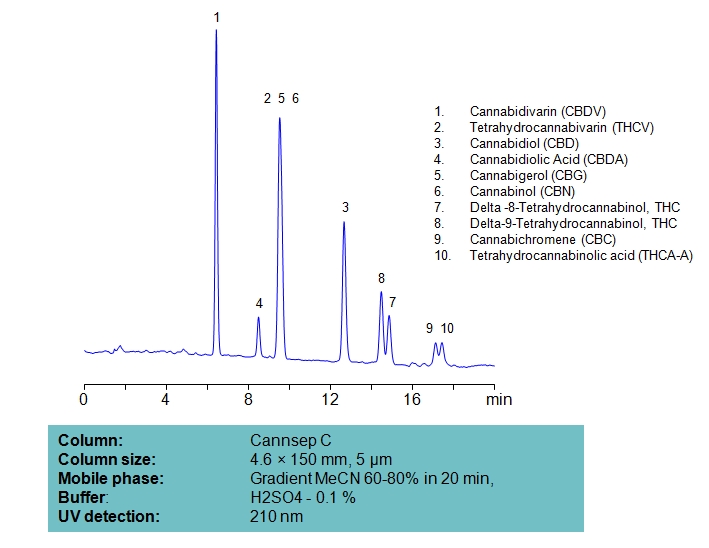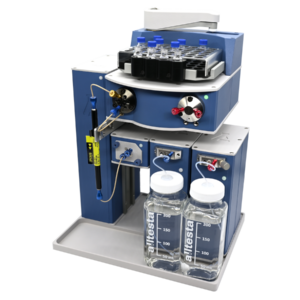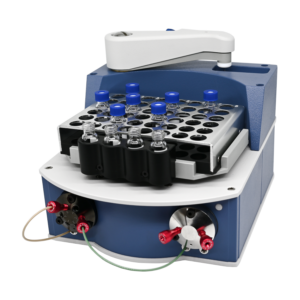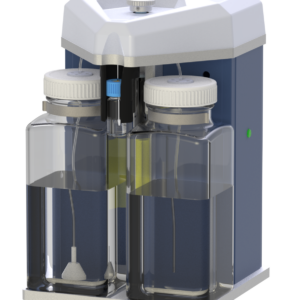HPLC Method for Tetrahydrocannabinol (THC), Delta-9-Tetrahydrocannabinol (THC), Tetrahydrocannabinolic acid (THCA-A), Tetrahydrocannabivarin (THCV), Cannabidiol (CBD), Cannabinol (CBN), Cannabichromene (CBC), Cannabidivarin (CBDV), Cannabigerol (CBG), Cannabidiolic acid (CBDA) on Cannsep C by SIELC Technologies
High Performance Liquid Chromatography (HPLC) Method for Analysis of Tetrahydrocannabinol (THC), Delta-9-Tetrahydrocannabinol (THC), Tetrahydrocannabinolic acid (THCA-A), Tetrahydrocannabivarin (THCV), Cannabidiol (CBD), Cannabinol (CBN), Cannabichromene (CBC), Cannabidivarin (CBDV), Cannabigerol (CBG), Cannabidiolic acid (CBDA).
Cannabidivarin (CBDV) is a non-intoxicating psychoactive cannabinoid with the chemical formula C19H26O2. Due to it demonstrating anticonvulsive properties, it is actively in Phase-2 trials for adult epilepsy, childhood epilepsy, and for Prader-Willi Syndrome.
Tetrahydrocannabivarin (THCV, THV) is a cannabinoid receptor type 1 antagonist with the chemical formula C19H26O2. It is prevalent in certain strains of Cannabis in central Asia and southern Africa. It is currently being researched as a potential treatment for obesity-associated glucose intolerances. It is also said to reduce appetite and have energizing effects.
Cannabidiol (CBD) is a phytocannabinoid with the chemical formula C21H30O2. It is used in a variety of ways. It’s only confirmed medical use is as epilepsy medication. It may help with pain, sleep, and addiction as an alternative to opioids, but due to limited clinical evidence, it’s regulations are dependent on the state. It is advised against using it during pregnancy due to unknown effects on fetal and infant development.
Cannabidiolic Acid (CBDA) is a precursor to Cannabidiol with the chemical formula C22H30O4. Research suggests that it might have anti-inflammatory, anti-emetic, anti-convulsant, and anti-carcinogenic properties, but not enough research has been done into it for it to be used as widely as other cannabinoids and the like.
Cannabigerol (CBG) is a non-psychoactive cannabinoid with the chemical formula C21H32O2. It is a minor constituent of cannabis. CBG that is derrived from marijuana is illegal, while CBG derived from hemp is legal as long as the THC content of hemp is less than 0.3% of dry weight. It was sold illegally by certain companies under unproven claims of being treatment against the COVID-19 virus and inflammation.
Cannabinol (CBN) is a mildly psychoactive phytocannabinoid with the chemical formula C21H26O2. It was the first cannabinoid to be isolated from cannabis in the late 1800s. It is legal in the United States as long as the THC concentration is 0.3% or less.
Delta-8-Tetrahydrocannabinol, also known as delta-8-THC and Δ8-THC, is a sychoactive cannabinoid with the chemical formula C21H30O2. It is less potent than delta-9-THC, it works in a similar way by binding to cannabinoid receptors in the brain. It’s legality is dependent on the state.
Delta-9-Tetrahydrocannabinol, also known as delta-9-THC and Δ9-THC, or simply THC, is the principal psychoactive constituent of Cannabis with the chemical formula C21H30O2. In pharmaceutical contexts, it is referred to as dronabinol and is used un nabiximols, which helps alleviate neuropathic pain, spasticity, overactive bladder, and more. Medical use of THC is allowed in the majority of the states in the United States of America, with less than half having it be legal for recreational use.
Cannabichromene (CBC), also known as cannabichrome, cannanbichromene, pentylcannabichromene and cannabinochromene is a phytocannabinoid with the chemical formula C21H30O2. Research suggests that it might have anti-inflammatory, anti-emetic, anti-convulsant, and anti-carcinogenic properties, but not enough research has been done into it for it to be used as widely as other cannabinoids and the like.
Tetrahydrocannabinolic acid (THCA), also known as conjugate base tetrahydrocannabinolate, is a precursor of Tetrahydrocannabinol with the chemical formula C22H30O4. Findings in regards to it being anything besides the THC precursor are limited, nor is it scheduled at the federal level in the United States, but it may be considered an analog of THC, leading to a risk if possessing or selling it.
Tetrahydrocannabinol (THC), Delta-9-Tetrahydrocannabinol (THC), Tetrahydrocannabinolic acid (THCA-A), Tetrahydrocannabivarin (THCV), Cannabidiol (CBD), Cannabinol (CBN), Cannabichromene (CBC), Cannabidivarin (CBDV), Cannabigerol (CBG), Cannabidiolic acid (CBDA) can be retained and analyzed using the Cannsep C stationary phase column. The analysis utilizes a gradient method with a simple mobile phase consisting of water and acetonitrile (MeCN) with a sulfuric acid buffer. Detection is performed using UV.
| Column | Cannsep C, 4.6 x 150 mm, 5 µm, 100 A, dual ended |
| Mobile Phase | Gradient MeCN 60-80% , 20 min |
| Buffer | H2SO4 – 0.1% |
| Flow Rate | 1.0 ml/min |
| Detection | UV, 210 nm |
| Class of Compounds |
Drug, Hydrophilic, Ionizable, Supplements |
| Analyzing Compounds | Tetrahydrocannabinol (THC), Delta-9-Tetrahydrocannabinol (THC), Tetrahydrocannabinolic acid (THCA-A), Tetrahydrocannabivarin (THCV), Cannabidiol (CBD), Cannabinol (CBN), Cannabichromene (CBC), Cannabidivarin (CBDV), Cannabigerol (CBG), Cannabidiolic acid (CBDA) |
Application Column
Cannsep C
Column Diameter: 4.6 mm
Column Length: 150 mm
Particle Size: 5 µm
Pore Size: 100 A
Column options: dual ended
Cannabidiol (CBD)
Cannabidiolic acid (CBDA)
Cannabidivarin (CBDV)
Cannabigerol (CBG)
Cannabinol (CBN)
Delta-9-Tetrahydrocannabinol (THC)
Tetrahydrocannabinol (THC)
Tetrahydrocannabinolic acid (THCA-A)
Tetrahydrocannabivarin (THCV)






